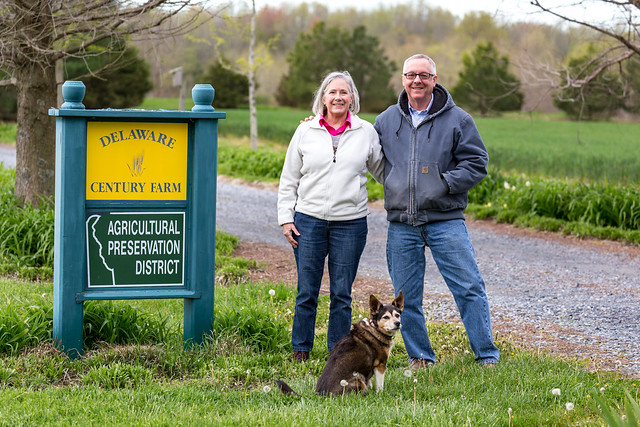
If ever he wondered if his family had made the right choice by restoring a wetland at their Delaware farm, Matt Spong laid that question to rest with the help of a duck.
Actually, a wood duck and her brood, seven lives that depend on the ecology at Viola Farms Inc.
“One day I saw something small bobbing in the water, and it turned out to be a female wood duck and six babies,” Spong recalled.
At that moment, he knew: working to keep a healthy wetland paid dividends exceeding the farm’s bottom line. Matt Spong and his wife, Marilyn, are ardent proponents of protecting their wetland and the creatures that live there.
At the same time, their corn-and-soybean farm, located on the Delmarva (Delaware, Maryland and Virginia) Peninsula, is a thriving operation. The farmers-turned-naturalists are working with the U.S. Fish and Wildlife Service (Service), as well as other agencies, to make sure their wetlands remain the sort of habitat where ducks and other creatures thrive.

Viola Farms has been in Marilyn Spong’s family for well over 150 years. The changes at her farm mirror what happened to wetlands across the country.
“For too long, most people took wetlands for granted,” said Bill Wilen, who spent 40 years working for the Service’s National Wetlands Inventory. The program provides detailed information on wetlands across the country.
“Wetlands,” he said, “began disappearing, acre by acre, as the country grew and farms spread.” The Service’s first Wetlands Status and Trends report, in 1983, offered a grim assessment of American wetlands.
“The report found that there was a net loss of wetland area equal to about twice the size of New Jersey between the 1950s and 1970s,” added Wilen.
“That caught federal officials’ attention and prompted wetland policy changes,” Wilen said. “Some policies, contained in the U.S. Farm Bill, put money to work correcting damages. Since the enactment of those policies in 1985, the government has spent billions restoring wetlands.”
In 1992, the U.S. Department of Agriculture’s Natural Resources Conservation Service (NRCS) established the Wetlands Reserve Program (WRP). Since then, private landowners, land trusts and others have enrolled 2.7 million acres through more than 14,000 agreements – an accomplishment representing more than $4 billion in NRCS delivered financial and technical assistance.
Some of the WRP money was spent at the Spong farm.
“The wetland used to just be a wet spot on our farm field,” said Spong, who’s also a registered landscape architect. “Most years, crops wouldn’t grow in the wet spot or yield was poor, so we stopped farming the area and looked into other options.”
The Spongs worked with the NRCS to restore that marginally productive farmland to its former natural state. Their collaboration restored the wetland and surrounding upland buffer, protecting a variety of living things.
That was more than 15 years ago. Now, they are reminded daily that they made the right choice.
“We see a whole lot more shorebirds and water turtles now, and we also see bald eagles that we rarely saw before the wetland was restored,” Spong said.
What happened at Viola Farms is not unique. The Service’s National Wetlands Inventory has tracked wetland change across the country. “The findings,” said Wilen, “show that agriculture – once the leading cause of wetland loss – is leading the way in reversing wetland loss trends.”
“This is a success story fueled by collaboration between federal and private partners that benefits not only individual land owners but all citizens,” added Wilen. With 75 percent of the Nation’s wetlands on private and tribal lands, the greatest potential for restoration lies in partnerships like this one.
The Spongs are happy with their collaboration. After finding the female wood duck and her young, the couple installed wood duck boxes designed to repel predators. They bought three wildlife cameras, just so they can keep an eye on their furry and feathered neighbors. “Thanks to the cameras we are able to identify individuals and watch their behavior,” Spong said.
The wetland has given them a changing annual show, too. The tract is filled with water in the early spring, but its water levels drop in warmer weather. By summer, the land is dotted with native wildflowers that the Spongs planted. Warmer weather eventually makes way for cooler climes. By winter, the native plants have faded from a vibrant green to various shades of beige.
The Spongs have made this winter landscape part of their family’s traditional holiday celebration.
“Every year, we host 40 friends and family to make holiday wreaths using natural materials. When we are done we all walk down to the wetland to enjoy it,” said Spong. “Marilyn’s family has been farming this land since the 1800s, but we can’t remember what it was like to not have the wetland. It is an important part of our daily life.”
The U.S. Fish and Wildlife Service helped support this Nature's Good Neighbor through the National Wetlands Inventory. In addition, the USDA provided funds for a wetland easement. A phone call or email is all it takes to learn more with one of our 250 private lands biologists. If you are interested in improving habitat for fish and wildlife on your land, find your local Partners for a Fish and Wildlife biologist.

